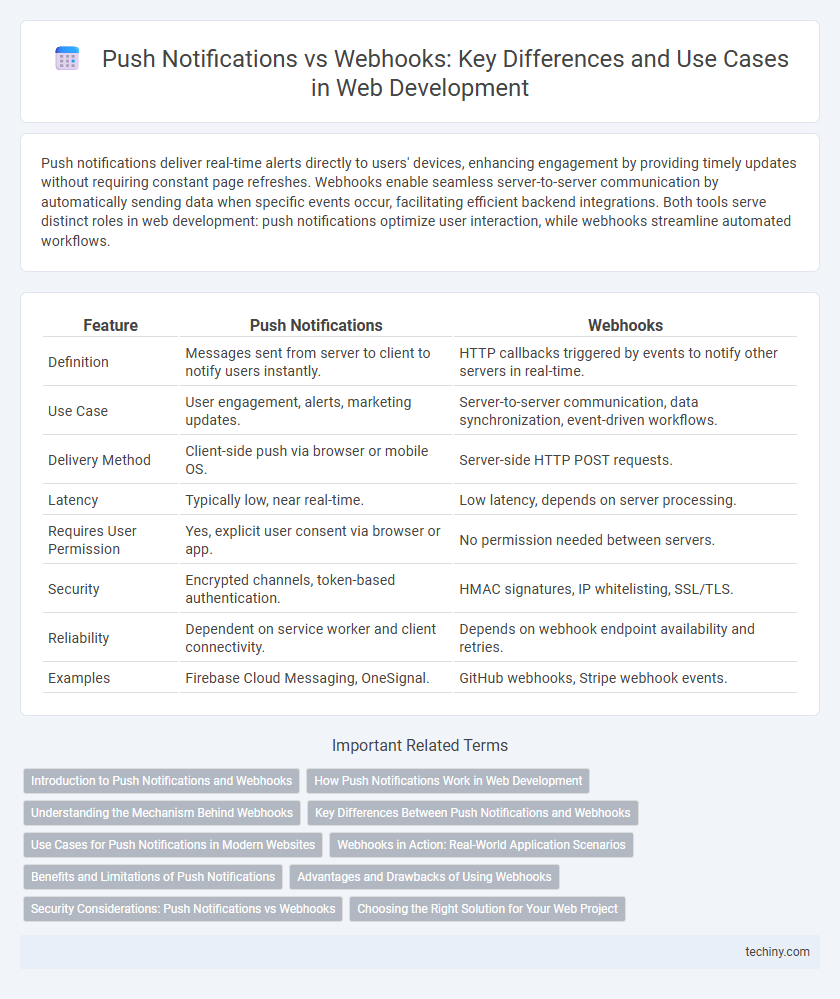Push notifications deliver real-time alerts directly to users' devices, enhancing engagement by providing timely updates without requiring constant page refreshes. Webhooks enable seamless server-to-server communication by automatically sending data when specific events occur, facilitating efficient backend integrations. Both tools serve distinct roles in web development: push notifications optimize user interaction, while webhooks streamline automated workflows.
Table of Comparison
| Feature | Push Notifications | Webhooks |
|---|---|---|
| Definition | Messages sent from server to client to notify users instantly. | HTTP callbacks triggered by events to notify other servers in real-time. |
| Use Case | User engagement, alerts, marketing updates. | Server-to-server communication, data synchronization, event-driven workflows. |
| Delivery Method | Client-side push via browser or mobile OS. | Server-side HTTP POST requests. |
| Latency | Typically low, near real-time. | Low latency, depends on server processing. |
| Requires User Permission | Yes, explicit user consent via browser or app. | No permission needed between servers. |
| Security | Encrypted channels, token-based authentication. | HMAC signatures, IP whitelisting, SSL/TLS. |
| Reliability | Dependent on service worker and client connectivity. | Depends on webhook endpoint availability and retries. |
| Examples | Firebase Cloud Messaging, OneSignal. | GitHub webhooks, Stripe webhook events. |
Introduction to Push Notifications and Webhooks
Push notifications enable real-time alerts directly to a user's device or browser, enhancing user engagement through instant communication. Webhooks facilitate automated data transfer between web applications by triggering predefined events, ensuring seamless integration and workflow automation. Both technologies play crucial roles in modern web development by improving interaction and connectivity across platforms.
How Push Notifications Work in Web Development
Push notifications in web development operate by enabling servers to send real-time messages directly to users' browsers or devices, even when the web application is inactive. This system relies on service workers and the Push API to subscribe users and deliver asynchronous updates, ensuring immediate engagement. The technology uses browser-specific push services, such as Google's Firebase Cloud Messaging and Apple's APNs, to facilitate reliable and scalable communication channels.
Understanding the Mechanism Behind Webhooks
Webhooks operate by enabling one application to send real-time data to another via HTTP callbacks triggered by specific events, ensuring immediate and automated communication without continuous polling. This event-driven mechanism allows servers to push information directly to clients or other servers, optimizing response times and reducing server load compared to push notifications. By leveraging webhooks, developers can build efficient, event-based integrations that maintain seamless data synchronization across web applications.
Key Differences Between Push Notifications and Webhooks
Push notifications deliver real-time alerts directly to users' devices, enhancing user engagement through immediate updates, whereas webhooks facilitate server-to-server communication by sending automated data payloads to specified URLs upon triggering events. Unlike push notifications that require user permissions and are typically client-side, webhooks operate in the backend without user interaction, providing seamless integration for data synchronization across applications. The key distinction lies in push notifications focusing on active user engagement with visible prompts, while webhooks emphasize backend automation for efficient event-driven workflows.
Use Cases for Push Notifications in Modern Websites
Push notifications in modern websites are essential for real-time user engagement, delivering instant alerts for new messages, updates, or personalized offers directly to the user's device. E-commerce platforms leverage push notifications to increase sales by promoting flash sales, abandoned cart reminders, and order status updates. News websites use push notifications to provide breaking news and personalized content updates, enhancing user retention and on-site activity.
Webhooks in Action: Real-World Application Scenarios
Webhooks enable real-time communication between applications by sending automated messages or data updates to a specified URL when an event occurs, eliminating the need for constant polling. Common use cases include triggering CI/CD pipelines after code commits, updating CRM systems instantly upon form submissions, and synchronizing inventory levels across e-commerce platforms. Their lightweight, event-driven architecture ensures efficient, scalable integration for diverse web development workflows.
Benefits and Limitations of Push Notifications
Push notifications enable real-time user engagement by delivering timely updates directly to devices, enhancing customer retention and interaction rates. They operate independently of active user sessions, ensuring messages reach users even when browsers are closed, though they require users to opt-in and may face restrictions on some platforms. However, push notifications can be limited by delivery delays caused by network issues and potential user fatigue from excessive alerts, impacting their overall effectiveness.
Advantages and Drawbacks of Using Webhooks
Webhooks offer real-time data delivery by automatically sending updates to a specified URL, reducing the need for constant polling and saving server resources. However, they rely on a stable internet connection and proper endpoint security, making them vulnerable to failure if the receiving server is down or compromised. Unlike push notifications that directly engage users, webhooks are suited for server-to-server communication, limiting their immediate impact on user experience.
Security Considerations: Push Notifications vs Webhooks
Push notifications require careful management of user permissions and secure transmission protocols like HTTPS to prevent unauthorized access and data leaks. Webhooks demand stringent validation of incoming requests through secret tokens or signatures to guard against spoofing and replay attacks. Both methods benefit from robust encryption practices and regular security audits to maintain data integrity and user trust in web applications.
Choosing the Right Solution for Your Web Project
Push notifications offer real-time, user-focused updates directly to devices, ideal for enhancing user engagement and retention in web applications. Webhooks provide server-to-server communication for seamless data synchronization and automated workflows, making them suitable for backend integrations and event-driven architectures. Evaluating project requirements like user interaction, latency, and system complexity helps determine whether push notifications or webhooks deliver the optimal solution for your web development needs.
push notifications vs webhooks Infographic

 techiny.com
techiny.com